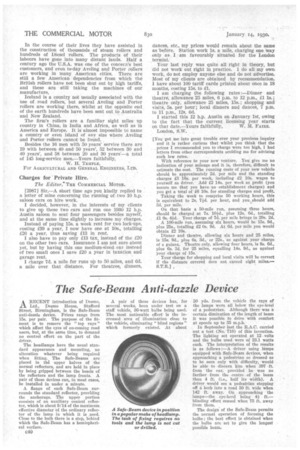The Safe-Beam Anti-dazzle Device
Page 62

If you've noticed an error in this article please click here to report it so we can fix it.
A RECENT introduction of Desmo, ti Ltd., Desmo House, Stafford Street, Birmingham, is the Safe-Beam anti-dazzle device. Prices range from 15s. per pair. The purpose of the fitment is to remove the "top rays" which affect the eyes of on-coming road users, but, at the same time, to dem,and no control effort on the part of the driver.
The headlamps have the usual standard appearance and mounting, no alteration whatever being required when fitting. The Safe-Beams are placed in the upper halves of the normal reflectors, and are held in place by being gripped between the bezels of the reflectors and the lamp fronts. A pair of these devices can, in most cases, be installed in under a minute.
A flange of each Safe-Beam surrounds the standard reflector, providing the anchorage. The upper portion consists of an auxiliary conical reflector, which is about 9/14 of the maximum effective diameter of the ordinary reflector of the lamp in which it is :used. Close to the bulb there is a step, behind which the Safe-Beam has a hemispherical surface. A pair of these devices has, for several weeks, been under test on a staff vehicle, 36-watt bulbs being used. The most noticeable effect is the increased area of illumination close to the vehicle, eliminating "blind regions" which formerly existed. At about 30 yds. from the vehicle the rays of the lamps were all below the eye-level of a pedestrian. Although there was a certain diminution of the length of beam it was possible to drive with comfort at speeds up to 35 m.p.h.
In September last the R.A.C. carried out a test (No. 710) of this invention. The lighting set operated at 12 volts and the bulbs used were of 23.1 watts each. The interpretation of the results is as follows driver using lamps equipped with Safe-Beam devices, when approaching a pedestrian so dressedas to be seen only with difficulty, would be able to discern him when 397 ft. from the car, provided he was no farther from the centre of the beam than 4 ft. (i.e., half its width). A driver would see a pedestrian stepping off 6 kerb into a road 30 ft. wide when 142 ft. away. On approaching the lamps-the eye-level being 4i ft.blinding effect ceased when 75 ft. away from them.
The design of the Safe-Beam permits the normal operation of focusing the bulbs; the best effect is obtained when the bulbs are set to give the longest possible beam.












































































































